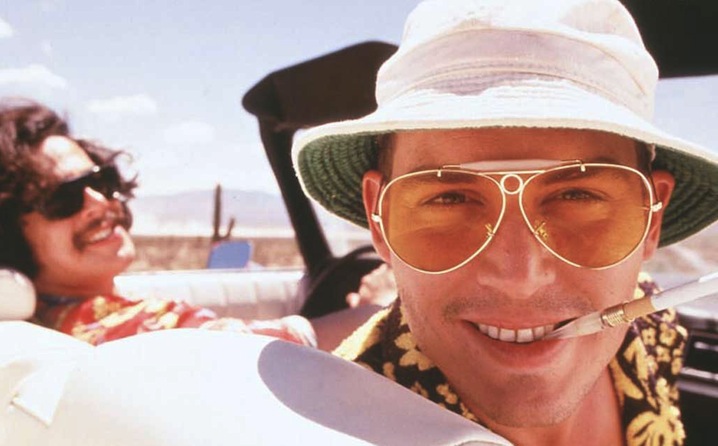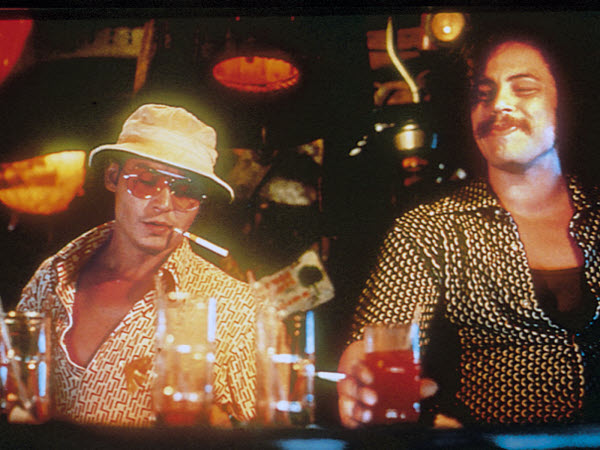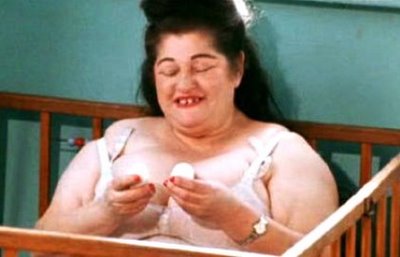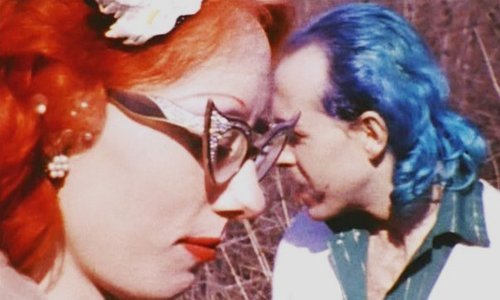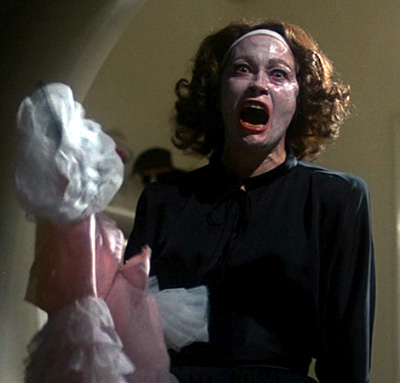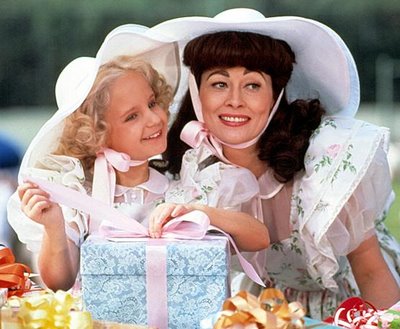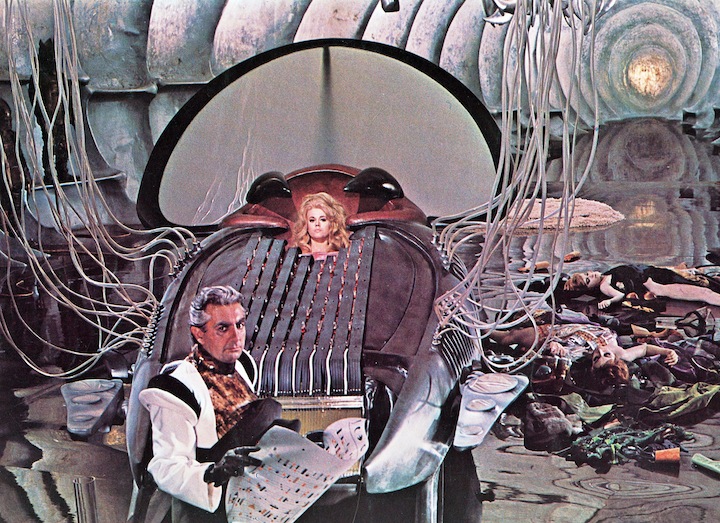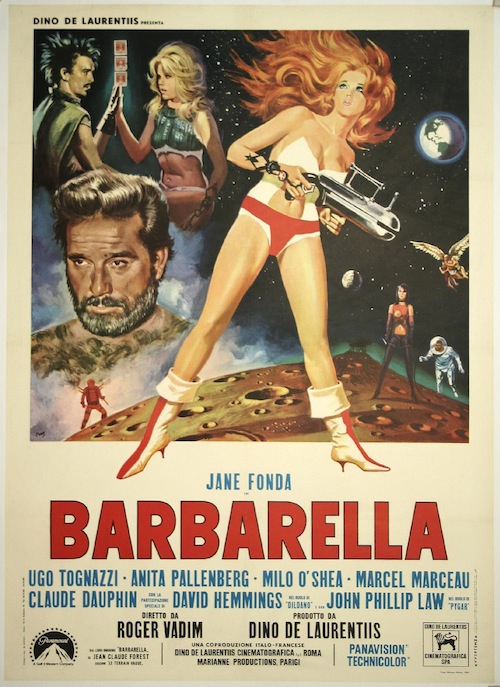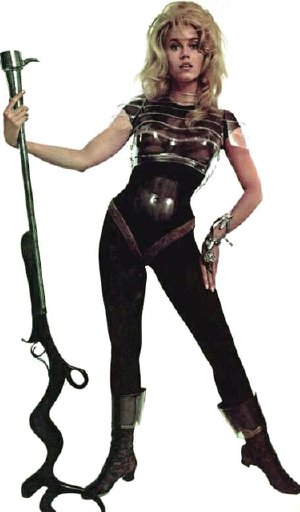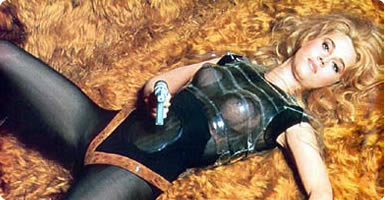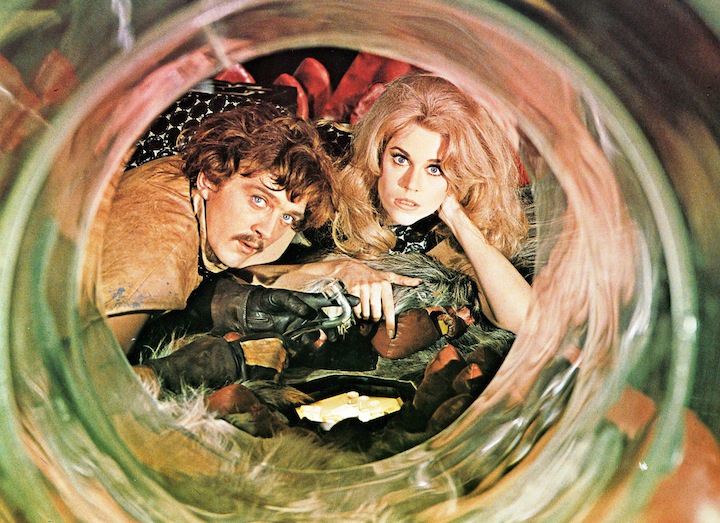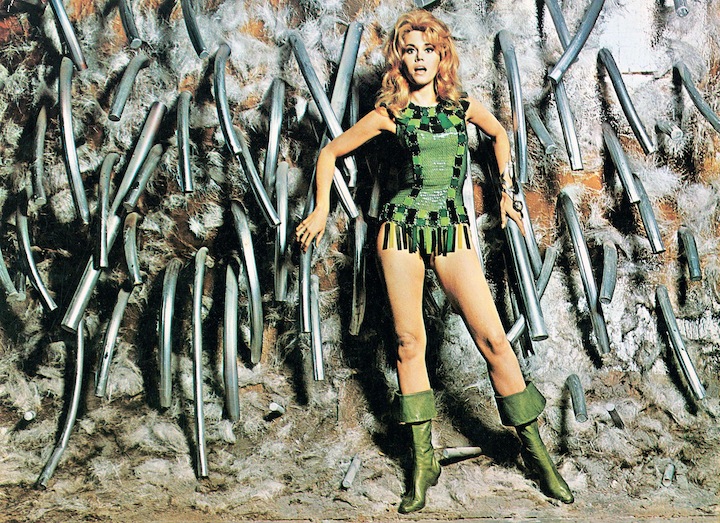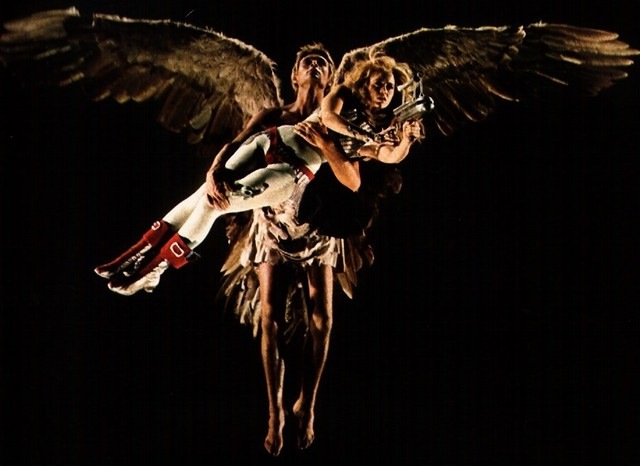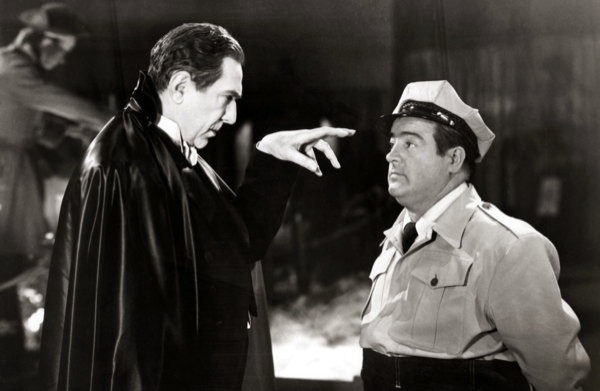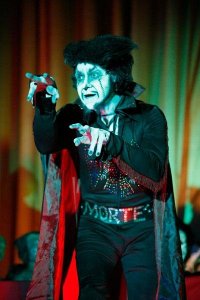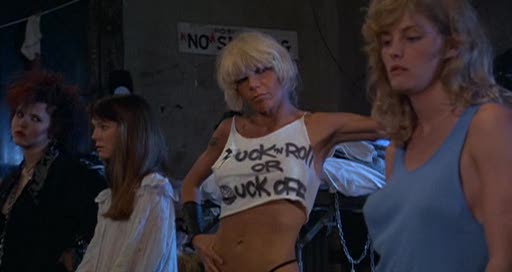 Blast-Off Burlesque’s TABOO LA-LApresents FEAR AND LOATHING IN LAS VEGAS (1998); Dir. Terry Gilliam; Starring Johnny Depp and Benicio del Toro; Saturday, September 28 @ 10 p.m. (pre-show cocktails at 9 p.m.); Ages 18+ only; Plaza Theatre; Trailer here.
Blast-Off Burlesque’s TABOO LA-LApresents FEAR AND LOATHING IN LAS VEGAS (1998); Dir. Terry Gilliam; Starring Johnny Depp and Benicio del Toro; Saturday, September 28 @ 10 p.m. (pre-show cocktails at 9 p.m.); Ages 18+ only; Plaza Theatre; Trailer here.
By Aleck Bennett
Contributing Writer
It’s time for Blast-Off Burlesque to tempt us with TABOO LA-LA at the Plaza Theatre! This time we venture into Bat Country with Hunter S. Thompson and Terry Gilliam for FEAR AND LOATHING IN LAS VEGAS!
It’s easy to celebrate Dr. Hunter S. Thompson for all the wrong reasons. FAR too many people see him only as a caricature: senses blazingly altered by some high-octane combination of hard drugs and bourbon, firing his guns at anything that dares blink in and out of his peripheral vision and ranting unintelligibly at imaginary phantasms. For these people, he’s become a counterculture hero not because of his accomplishments or the words he’s written, but because of a persona.
Sure, it’s a persona that he called into existence and encouraged to a large extent. Why? Because, goddammit, you need a larger-than-life personality to stand up next to those works of his. You can’t be some milquetoast beat reporter and deliver epic pieces of immersive journalism like “The Kentucky Derby Is Decadent and Depraved,” “Freak Power in the Rockies” or “The Banshee Screams for Buffalo Meat.” Nor can you be a typical Washington Beltway insider and compose the incredible series of articles that would eventually make up FEAR AND LOATHING: ON THE CAMPAIGN TRAIL ’72, perhaps the greatest piece of political journalism ever written. No, you’ve got to be a daredevil. You’ve got to be a shaman, using sacramental substances to achieve the frenzied mental state needed to venture into the heart of darkness and divine the inner essence of a situation. You’ve got to be the kind of drug-crazed madman who is unafraid to sacrifice accuracy on the altar of journalism to summon forth the Elder Gods of Truth.
And if you’re not that person, then you need to invent that person and become that person.
Which brings us to Raoul Duke and his journey with his personal attorney, Doctor Gonzo, into the godforsaken land of Las Vegas in 1971—the story of which would become Hunter S. Thompson’s landmark novel FEAR AND LOATHING IN LAS VEGAS: A SAVAGE JOURNEY TO THE HEART OF THE AMERICAN DREAM.
Thompson’s tale is actually a portmanteau of two trips into the desert city with his friend Oscar Zeta Acosta, lawyer and Chicano activist. The first was intended to be a retreat for the two of them to discuss an article Thompson was writing about the death of Mexican-American journalist Rubén Salazar. Thompson used an invitation from SPORTS ILLUSTRATED to write a series of photo captions about the Mint 500 motorcycle race as an excuse, and the two of them descended onto the city.
250 words. That’s all they wanted.
Instead, he spent 36 hours straight, “feverishly writing in my notebook,” describing the pair’s wild adventures in Las Vegas and creating the expansive first part of the novel. And then, after the insane experience they undertook, they went back. Thompson took an assignment from ROLLING STONE to report on the National District Attorneys Association’s Conference on Narcotics and Dangerous Drugs held a few weeks later in Vegas, and further explored an idea that manifested during the first trip: that the rebellion of the 1960s had failed, and that the American Dream was now manifest in the crass, loud and materialistic oasis of Las Vegas.
Thompson combined the two trips into one story, which ROLLING STONE published as a two-part serial illustrated by Ralph Steadman, and which was later compiled into a novel. In creating what he admitted was “an essentially fictional framework,” Thompson assigned himself and Acosta pseudonyms: Raoul Duke (a nom de plume frequently used by Thompson and originally used as his byline for the ROLLING STONE serialization) and Doctor Gonzo. As for the book itself, it’s hard to say how much of what is written about is strictly accurate. It’s easy to say that the whole thing is true. What may have appeared at first as a wacky drug-fueled adventure turned into a work mournful of the failure of the ‘60s revolution, furious at the insane excess of artifice and celebration of the futile pursuit of money that is Las Vegas, and aghast that Vegas survived the revolution to stand in representation of the American Dream.
 For years, the thing was regarded as being as unfilmable as NAKED LUNCH. Surreal, hallucinatory and depicting any number of illegal and violent acts by its protagonists, it just seemed to be too much to exist on a movie screen. Sure, they tried. Martin Scorsese and Oliver Stone both gave it a shot, but only one movie wound up being made in the wake of those early efforts. WHERE THE BUFFALO ROAM (which attempted to shoehorn “Fear and Loathing at the Super Bowl,” “The Banshee Screams for Buffalo Meat” and LAS VEGAS into one movie) starred Bill Murray, and was widely panned, particularly by Thompson himself. He praised Murray’s performance, but said the movie was saddled with “a bad, dumb, low-level, low-rent script.”
For years, the thing was regarded as being as unfilmable as NAKED LUNCH. Surreal, hallucinatory and depicting any number of illegal and violent acts by its protagonists, it just seemed to be too much to exist on a movie screen. Sure, they tried. Martin Scorsese and Oliver Stone both gave it a shot, but only one movie wound up being made in the wake of those early efforts. WHERE THE BUFFALO ROAM (which attempted to shoehorn “Fear and Loathing at the Super Bowl,” “The Banshee Screams for Buffalo Meat” and LAS VEGAS into one movie) starred Bill Murray, and was widely panned, particularly by Thompson himself. He praised Murray’s performance, but said the movie was saddled with “a bad, dumb, low-level, low-rent script.”
A direct adaptation eluded filmmakers for years, but that ended in 1998. After Rhino Films went through protracted tangling with director Alex Cox (whose screenplay Thompson viscerally hated), Terry Gilliam was brought on board to helm the film adaptation of the novel, and his surreal vision was a perfect match for the material. Though Gilliam had never used drugs, he researched the effects of all the chemicals used by the characters to create a series of visual effects that would mirror how the drugs would have affected their perception. The end result, while not exactly matching the horrifically ugly darkness of Ralph Steadman’s illustrations, stands on its own as a fully-formed take on Thompson’s subject matter.
Johnny Depp and Benicio del Toro were cast as Duke and Gonzo, respectively, and both underwent extensive preparation for their roles. Del Toro gained 45 pounds and immersed himself in studying the life of Oscar Zeta Acosta, and Johnny Depp spent four months living with Thompson at his Woody Creek ranch. Depp assembled his wardrobe from Thompson’s clothes of the time, wore a pendant of Thompson’s that was a gift from Acosta, and shaved his head in imitation of Thompson’s own male pattern baldness. The research and work paid off in spades. Depp and del Toro inhabit their roles perfectly. While they may come across as slightly cartoonish exaggerations of both Thompson and Acosta, it must be remembered that the Duke and Gonzo of the novel are slightly cartoonish exaggerations of Thompson and Acosta.
Terry Gilliam stated that he wanted the film to be polarizing—that he wanted it to be known as both the greatest and worst film of all time. And, thusly, it sharply divided critics: it currently holds a 50% average on the review aggregator ROTTENTOMATOES.com. Meanwhile, the film was a huge commercial failure. Filmgoers wanting to see the handsome Depp and del Toro got presented with a pair that were deliberately ugly. Filmgoers wanting to see a modern drug comedy wound up with something less a comedy and more a tragedy. And filmgoers wanting to see the Thompson perpetuated by DOONESBURY’s “Uncle Duke” character (and practically every other mass media depiction of the author) wound up with the only-slightly-fictionalized Thompson of the book, which is far closer to Thompson the man than Thompson the caricature.
Thankfully, due to home video releases, the film has built up a large, faithful audience, and it’s that crowd which is invited to the Plaza Theatre as Blast-Off Burlesque’s TABOO LA-LA brings us a screening of Gilliam’s adaptation. The pre-show kicks off at 9 p.m. with complimentary cocktails served up in the lobby, and then things kick into high gear with a live stage show from Blast-Off Burlesque featuring special guests Tom Jones, Elvis (somehow I’m guessing that these might not be the actual Tom Jones and Elvis) and Batastic. There will also be a Gonzo Costume contest and an Ether Walk contest with prizes from Libertine and the Cherry Blossom Salon, as well an art display of Lucy’s Barbara Streisand portraits! So come down and enjoy one of the greatest films of the 1990s while celebrating Hunter S. Thompson for all the right reasons.
Aleck Bennett is a writer, blogger, pug warden, pop culture enthusiast, raconteur and bon vivant from the greater Atlanta area. Visit his blog at doctorsardonicus.wordpress.com

